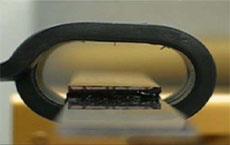Magnetic glue can be switched on and off.
A new kind of superglue that uses nanoscale magnetic particles to bond and de-bond on command has been developed by German scientists.
Commercial adhesives are usually hardened by heat. This can require long periods for glues to cure at room temperature. Releasing these bonds requires further heating, which can damage heat-sensitive materials, such as plastics.

The addition of a magnetic additive by Andreas Hartwig at the Fraunhofer Institute, Munich, and colleagues at chemical company Degussa, Dusseldorf, Germany has produced an adhesive that bonds and de-bonds without having to heat the materials being stuck together.
This magic ingredient is a powder of iron oxide particles that have been embedded in silicon dioxide nanoparticles. The particles are super-paramagnetic, meaning that they behave like tiny magnets when an external magnetic field is applied to them. Exposing the particles to a high-frequency, alternating magnetic field, causes them to oscillate rapidly and, in turn, heat the adhesive.
’We can use the electromagnetic field at a low power to warm the glue enough to cure it, and a higher power heats it sufficiently to de-bond it. This could be applied to any adhesive which is cured by heat,’ explained Hartwig.
The new technology also has environmental implications.
Malcolm Butler, who manages the UK’s Microsystems and Nanotechnology Network, said, ’this could be very useful for the purpose of recycling and reusing plastics. For example, when a car is scrapped, the plastics and metals bonded together need to be separated. They are usually not compatible or recyclable when they’re melted down [but] can be reused if they are kept intact.’
The European Commission’s End of Life Vehicles directive has attempted to address the environmental impact of waste generated by scrapped vehicles. It passed into European law in October 2000 and set a reuse and recovery target of 85 per cent of materials from scrapped vehicles by January 2006 and 95 per cent by 2016.
The German adhesive is not the only advance in this area. UK company De-Bonding, Tingley, has developed its own reversible bond technology, which is being used to remove car windscreens.
The technology involves tiny expandable microspheres, which have an outer shell of thermoplastic resin and a core of a volatile vaporising agent like a gas or explosive material. These are added to the adhesive and remain inactive within the bond. When heat energy is applied to the adhesive, the microspheres expand to over 100 times their volume causing the bond to break.
’This method is cost effective because you can apply any kind of energy to generate the heat and make the microspheres expand,’ said Peter Bain, managing director of adhesive specialists De-Bonding. ’For windscreen removal, you can just beam infrared light across the windscreen to expand the microspheres and the screen will come out cleanly.’
De-Bonding is now involved in two projects under the European Commission’s sixth framework programme for research. One of these, Ilipt (Intelligent Logistics for Innovative Product Technologies), is a €66 million (?45 million) project, part of which aims to design and build a ’modular car’ that could be fully disassembled and recycled.
Victoria Gill






No comments yet